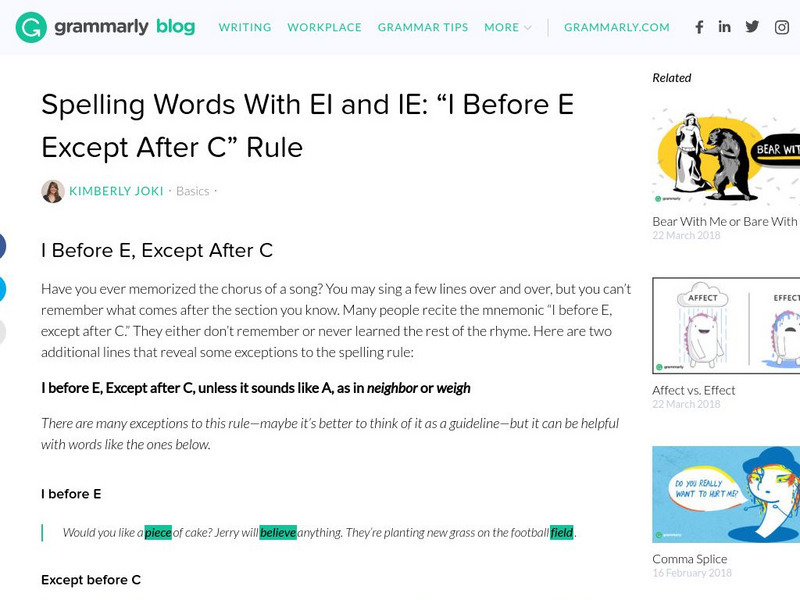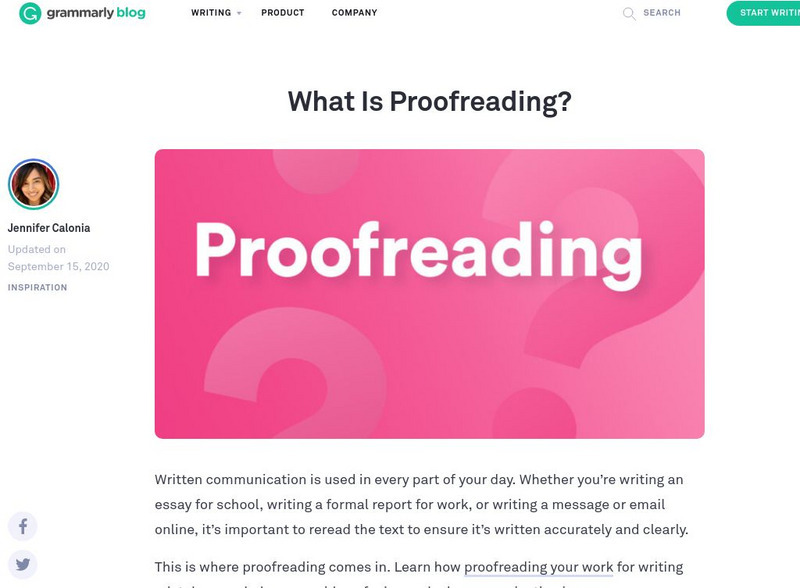Grammarly
Grammarly Blog: Missing Comma Before a Question Tag
Rules and examples for using commas when writing a question tag at the end of a sentence.
Grammarly
Grammarly Blog: Comma Emphasizing Contrasting Ideas
This page focuses on the use of commas around contrasting ideas to emphasize that the subject has been modified; examples are provided. Signal words for contrasting ideas include not, unlike and never.
Grammarly
Grammarly Blog: Comma Between Direct Quote and Attributive Tag
This page explains the comma placement needed between a direct quote and its speaker dependent upon the location of the attributive tag. It includes examples of various tag locations.
Grammarly
Grammarly Blog: Simple Past Tense
An explanation with examples of simple past verb tense in sentences.
Grammarly
Grammarly Blog: Capitalization: Countries, Nationalities, and Languages
This page explains the rule requiring the capitalization of the names of countries, nationalities, and languages with examples of each.
Grammarly
Grammarly Blog: Abbreviations
This site focuses on abbreviations including definitions, acronyms and initialisms, abbreviations for courtesy titles and academic degrees, Latin abbreviations, and other common abbreviations including time and dates, places, and units...
Grammarly
Grammarly Blog: Anyway, Anyways, or Any Way
This page focuses on formal and informal use of "anyway," anyways," and "any way." Anyways is very infomal and should not be used; "anyway" is correct to mean "in case of" and "any way" should be used for all other situations. Examples...
Grammarly
Grammarly Blog: Past Perfect Tense
An explanation with examples of past perfect verb tense in sentences.
Grammarly
Grammarly Blog: Wrong Participle
An explanation with examples of using participles correctly in sentences.
Grammarly
Grammarly Blog: Prepositions
An explanation of the use of prepositions and links to specific preposition usage rules.
Grammarly
Grammarly Blog: What Are Prepositions?
This page defines prepositions and provides examples.
Grammarly
Grammarly Blog: Uses of Prepositions
This page explains the uses of prepositions including to show direction, time, location, and spatial relationships. Examples are provided.
Grammarly
Grammarly Blog: Prepositions of Spatial Relationship
An explanation with examples of prepositions that descript spatial relationships.
Grammarly
Grammarly Blog: Nouns and Prepositions
An explanation with examples of how nouns and prepositions can work together in a sentence.
Grammarly
Grammarly Blog: Avoid Unnecessary Construction and Prepositions
This page focuses on the need for clear and concise language when writing.
Grammarly
Grammarly Blog: Spelling Words With Double Consonants
Spelling rules and examples for words with double consonants in both single and multiple syllable words. L.11-12.2b Spelling
Grammarly
Grammarly Blog: Simple Future Tense
An explanation with examples of simple future verb tense in sentences.
Grammarly
Grammarly Blog: Spelling Words With Ei and Ie
The page focuses on the rules and examples for spelling words with "ei" and "ie" including the "I Before E Except After C" rule and the "I before E, Except after C, unless it sounds like A, as in neighbor or weigh" rule. L.9-10.2c Spelling
Grammarly
Grammarly Blog: Every Time
This page explains and provides the rules for use of the two-word compound "every time."
Grammarly
Grammarly Blog: Spelling
An explanation of the importance of spelling. Links to additional information about specific spelling rules are provided.
Grammarly
Grammarly Blog: 5 Basic Proofreading Habits
A list of the five specific things to focus on when proofreading your writing.
Grammarly
Grammarly Blog: I Before E Except After C: 9 Helpful Spelling Rules
This site provides nine important spelling rules and examples. L.9-10.2c Spelling, L.11-12.2 Cap/Punc/Spell
Grammarly
Grammarly Blog: What Are Homophones?
This page explains homophones (words that sound alike, but have different spellings and meanings) and provides the most common examples.
Grammarly
Grammarly Blog: What Is Proofreading?
Explains what proofreading is, how it differs from editing, and provides tips on how to proofread.
























